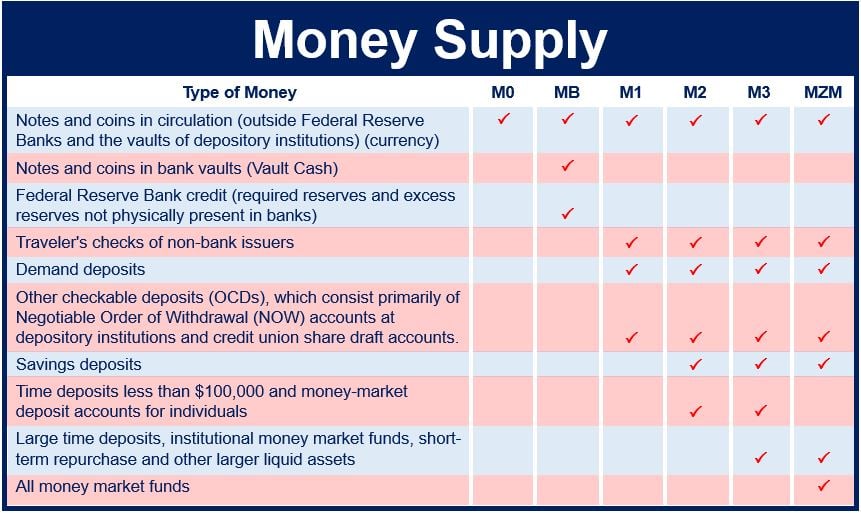The money supply is the total amount of money present in a country’s economy – all its money. There are several ways of measuring this, from the narrow definition (narrow money), which is classified as M0 or M1, to the broad definition (broad money), which may be classified as M2, M3 or M4.
A country’s money supply is recorded and published periodically, usually by the central bank or the government.
Economists, business people, financiers, investors, politicians and public employees closely monitor changes in the money supply, because it can impact inflation levels, the exchange rate, and the business cycle (the shift from economic growth to contraction, and vice-versa).
 Different ways of measuring the money supply as determined by the US Federal Reserve System. (Data Source: Wikipedia)
Different ways of measuring the money supply as determined by the US Federal Reserve System. (Data Source: Wikipedia)
The OECD (Organization for Economic Co-operation and Development) says the following regarding money supply:
“The money supply is the total amount of money in circulation in a country or group of countries in a monetary union.”
“There are several ways in which this can be calculated: M1 is a measure of money supply including all coins and notes plus personal money in current accounts; M2 is M1 plus personal money in deposit accounts; M3 is M2 plus government and other deposits.”
Money supply and inflation
The total amount of money in an economy generally has an impact on price increases or declines (inflation/deflation).
Empirical evidence has shown that if the money supply grows rapidly, inflation will increase. At the turn of the century Zimbabwe significantly increased the money supply. Within four years inflation had reached 624%. It shot up to 1,730% by 2006, and then a whopping 11,000% in 2007.
Most nations rely on their central banks to make sure their monetary policy, which includes carefully monitoring the money supply, controls inflation.
Many economists point out that there are situations in which increasing the money supply helps the economy and does not fuel runaway inflation. Following a recession, for example, when resources are still underutilized, raising the money supply can help boost production (but not inflation).
The US Federal Reserve System (Federal Reserve) says that money supply is less important today as a guide for monetary policy, compared to some decades ago.
The Federal Reserve writes on its website:
“Over recent decades, however, the relationships between various measures of the money supply and variables such as GDP growth and inflation in the United States have been quite unstable. As a result, the importance of the money supply as a guide for the conduct of monetary policy in the United States has diminished over time.”
Video – Money Supply
